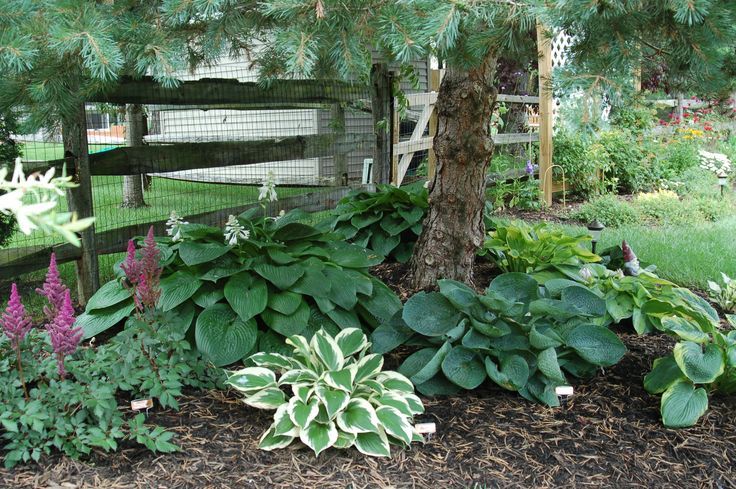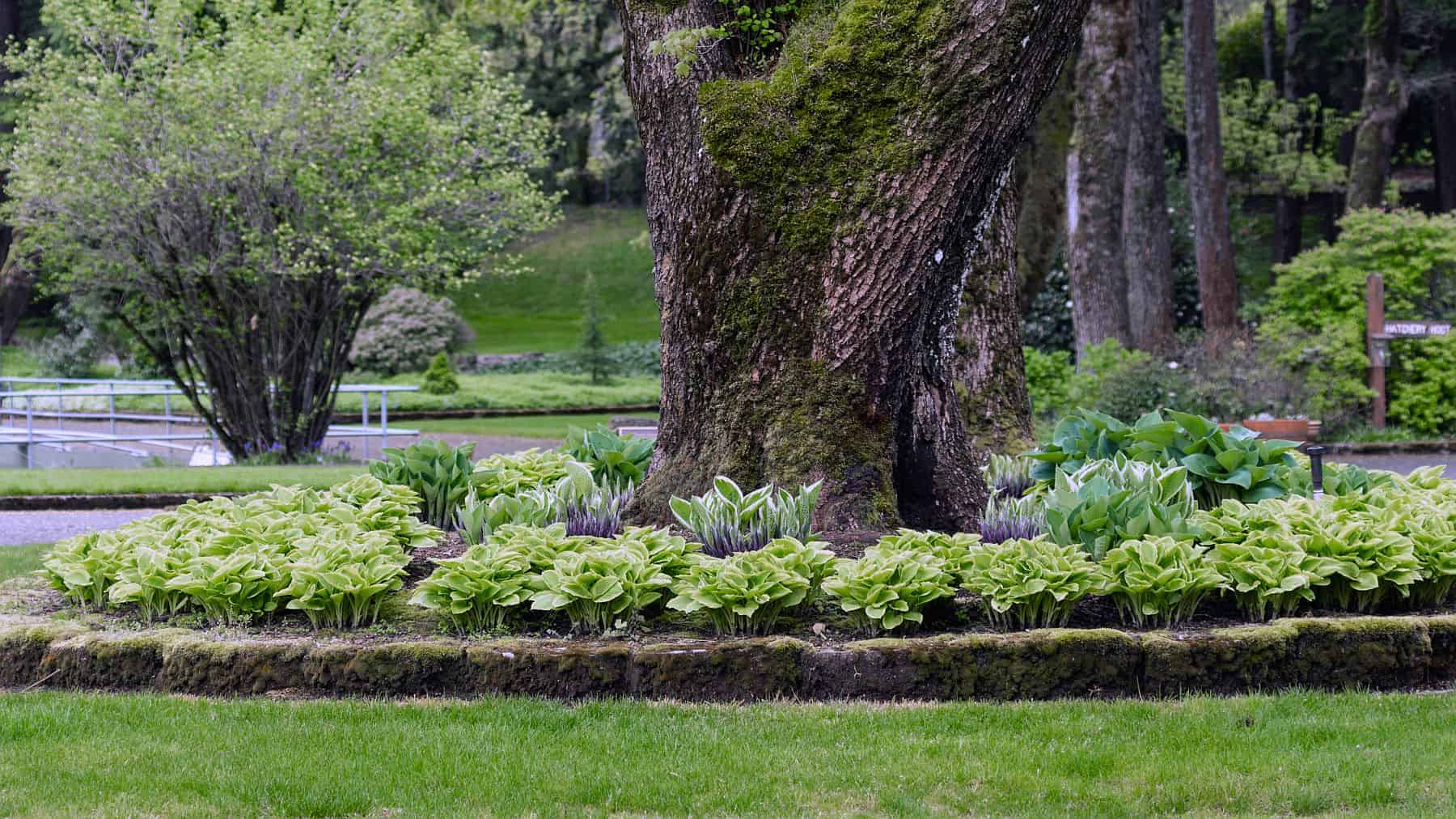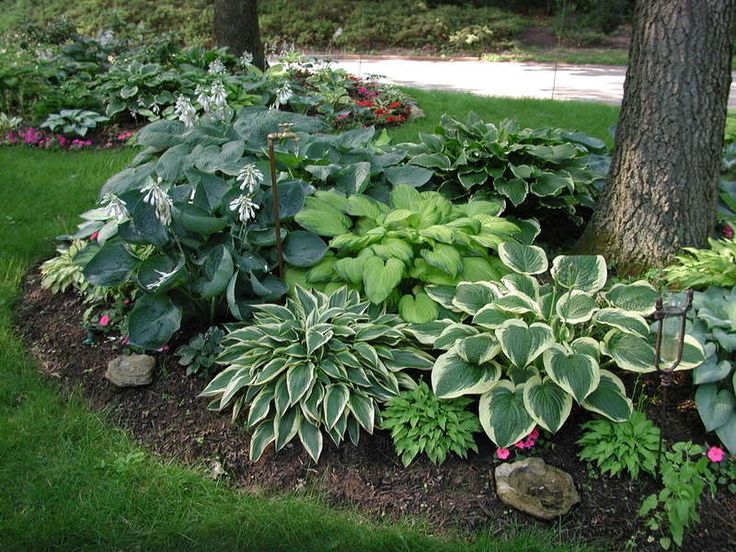If organic matter is added to the soil before planting, the shade-loving hostas can thrive under pine trees. To flourish to their full capacity, hostas beneath pine trees require regular applications of mulch and fertilizer throughout the growing season.
The following five steps can help you cultivate hostas underneath pine trees.
- Before planting, amend the soil with a lot of compost and leaf mold to assist the soil retain moisture.
- Every spring, add mulch around the hosta to increase the soil’s texture and stop it from drying up.
- In order to combat the dry conditions under a pine tree canopy, water the hosta ideally with a gradual soak, drip line.
- Because the soil beneath pine trees can be deficient in nutrients, add fertilizer.
- Throughout the growing season, keep a close eye on the soil’s moisture levels.
The roots of the pine trees will compete with those of the hostas for water and nutrients, so read on for the best methods and simple fixes for growing hostas effectively next to pine trees.
Table of Contents
Amend the Soil with Organic Matter
Dry soil with years’ worth of pine needles in various stages of decomposition will be present directly beneath mature pine trees.
It is a common fallacy that once pine needles are fully digested into compost, the soil would be too acidic to support the growth of plants like hostas. Fortunately, pH 6 is the ideal level of acidity for hosta growth.
Under pine trees, the unaltered soil will be:
- Too dry for hostas, in part because the canopy prevents rain from falling.
- Low fertility or perhaps a nutritional profile that isn’t as full.
- Not being able to keep enough moisture for hostas, which require constant moisture, to thrive.
Therefore, you must include a sizable amount of organic matter when planting the hosta. When growing hostas, a mixture of compost/leaf mold and well-rotted manure produces excellent results.
As hostas require a regular supply of moisture to maintain their shape and structure, the leaf mould in particular can withstand 500 times its own volume of moisture, making it the ideal material.
Together with the compost, the manure’s high nutritional content will help the soil preserve its fertility over time.
- In order to make the soil more ecologically active and to benefit hostas, organic material will also encourage microbial and helpful worm activity. Worm castings concentrate essential minerals into a chelated form that is easier for hostas to absorb.
- The larger the amount of soil you modify, the better the hosta’s long-term prospects for health. When you are digging your hole for planting the hosta, dig out a much wider area of dirt than the root ball of your plant.
- The size of the particular hosta type will influence how big your hole has to be; for example, “Jade Cascade” hostas can reach a mature width of 3 feet, whilst “Amber Tiara” hostas only reach a width of 14 inches.
- Make sure the hosta’s crown, which is where the stems and roots converge, is at ground level when you plant it.
- Hostas are heavy feeders, so back fill the hole with a mixture of compost and ideally some manure. Firm the soil for some support without compacting it, as the roots want a permeable structure so they can successfully establish themselves.
- After planting, for optimal results, water the area well with up to 3 gallons for larger types and about 1-2 gallons for medium or smaller varieties. You should also spread mulch over the nearby soil.
Why you Need to Add Mulch to Hostas under Pines
- soil composition
- Possibilities for retaining water
- replenishing the nutrients collected by the heavily fed hostas by improving the soil each year with additional nutrients
Due to poor soil conditions and the fact that the canopy simply intercepts a substantial quantity of rainfall, pine trees can remain extremely dry. As a result, less water reaches the hostas planted beneath them.
Mulch should be applied in a depth of 1-2 inches over the hosta’s surrounding soil. But it’s crucial to allow a 6-inch space between the mulch and the hosta’s crown.
Mulch can be placed at any time of year, but it is frequently ideal to do so in the beginning of spring to offer nutrients for the upcoming growth season and to conserve moisture for the warmer spring and summer months.
The same kinds of materials that you would use to first amend the soil are the finest for mulching around hostas to counteract the dryness (the major concern) under pine trees.
Manure, well-rotted general compost, leaf mold, and grass clippings are also suitable alternatives. Avoid using mulches like wood chips or bark since they are ineffective at holding moisture and provide very little to soil fertility.
Additionally, the mulch will prevent weed development, which will save you time and work.
A nice 2 inch covering of mulch will act as a huge sponge, soaking up the water and reducing the rate at which soil would evaporate. Despite this, the mulch will still maintain a porous, friable structure that permits extra water to drain away. The roots must always have access to moisture, but they do not like to sit in soggy ground or in pools of water.
Water with a Drip Line for Hostas under Pines
The main issue with growing hostas beneath pine trees is dry soil. The hostas’ huge leaves transpire water during the day, creating a slight vacuum that prompts additional water to be pulled up through the roots. The form, gloss, and lush feel of the huge hosta leaves are a result of this internal pressure and steady moisture delivery. (Turgor Pressure, a procedure, is used to achieve this.)
As a result, I cannot stress enough how crucial it is to maintain a good watering schedule when taking care of hostas in dry conditions, especially when they are in a water-contest with pine trees.
Larger hostas should be watered using a hose if a soaker hose can’t be laid down close to the planting area because of the amount of water needed.
On hot summer days, the larger types, such “Sum and Substance,” may require up to 3 gallons of water, while the medium- to small-sized species only require 1-2 gallons. You should water hostas once every two to three days on more cloudy days or after a light rain.
Hostas are known for their thirst for moisture, therefore it’s crucial to provide them enough of water. Doing so will encourage the roots to sunk deep into the soil, where they may access moisture reserves that are otherwise scarce beneath pine trees.
Hostas should always be watered in the morning to give them moisture for the day. When caring for hostas, slugs and snails are a common problem, and watering at night will encourage them.
Monitor Soil Moisture Levels
It will be beneficial to pay close attention to the moisture levels when growing hostas beneath pine trees.
Use your finger to frequently check the soil’s moisture level. Give your hosta a large drink whenever the soil seems a little dry or just a little moist. This is a useful precaution to avoid hostas drying out or dying in dry weather.
Hostas should flourish in the shaded area under a pine tree as long as the soil has been prepared by adding organic matter before planting, mulch is applied periodically, and water is applied frequently.
Fertilizer is Essential for Hostas under Trees
When growing hostas underneath pine trees, fertilizer is critically necessary because the hosta will be immediately vying for resources with the much larger pine tree.
Mulch will help the soil become more fertile, but it might not have all the nutrients the hosta need in the right concentration for it to grow to its full size, shape, and glossy leaves, especially if the pine roots are competing with the hosta for the same nutrients.
Therefore, a fertilizer is required, especially with the larger varieties, to get the optimum results from the hosta in terms of size, shape, and the glossy sheen to the luxuriant leaves.
Hostas are not picky feeders, although they do require a lot of nitrogen (N), phosphorous (P), and potassium (K). It is ideal to replenish these nutrients and the trace elements that support the health of hostas using a general balanced plant fertilizer.
The ideal balance will be provided by a renowned brand of fertilizer (such as miracle grow). Beginning in early spring when the weather has warmed and there is no possibility of frost, apply once every two weeks. Apply every two weeks till the middle of August.
After August, avoid fertilizer applications because they will encourage new growth as the hostas get ready for their winter dormancy.
Removing Pine Roots when Planting Hostas
Finding room in the network of shallow pine tree roots is a constraint when it comes to planting hostas underneath pine trees.
The larger hosta types, like Hosta ‘Sagae,’ which may grow to be 70 inches across, may be very difficult to grow if there is a dense network of roots from multiple pines or other nearby trees, so you will need to plant smaller varieties like ‘Gold Edger’.
To make room for a hosta plant, which can require a relatively tiny planting area for the smaller varieties, it might be able to strategically cut some pine tree roots with an axe.
The demand for fertilizing, watering, and mulching will grow proportionally as the number of roots in the planting area increases as the hostas fight with the pine trees for moisture and nutrients.
Main Points
- Hostas can thrive in pine tree shade provided the soil has been prepared before planting with a lot of organic materials.
- Hostas require a continuous moisture supply and nutrients to maintain their structure and health, so useful amendments to add are compost, leaf mold, and well-rotted manure.
- The dry soil beneath pine trees has to be mulched in the spring to help it retain more moisture and gradually enhance the soil’s structure.
- Fertilizer is necessary for hostas growing around pine trees so they can outgrow the pine roots and reach their full potential.
- You must water hostas with extra care when they are grown under pine trees. Installing a drip pipe or soaker hose would be ideal, but you can also water huge hostas with 3 gallons during hot weather and lesser types with 1-2 gallons every few days. To assist the soil retain water, add mulch and check the soil moisture frequently.
- If the soil around you has a lot of shallow pine roots, plant smaller hosta kinds. To make room for hostas, you can remove a few pine tree roots with an axe without doing long-term damage to the pine tree.
FAQ
Do hostas do well under trees?
Hostas often flourish when planted on the north or east side of a house or in a location shaded by trees. One warning from Lakowske applies when planting a hosta beneath a canopy of leaves: “Don’t plant them beneath maple trees.
Will hostas survive under pine trees?
If organic matter is added to the soil before planting, the shade-loving hostas can thrive under pine trees. To flourish to their full capacity, hostas beneath pine trees require regular applications of mulch and fertilizer throughout the growing season.
What is the best ground cover for under pine trees?
Grow some groundcovers that can withstand the shade under the tree. Some plants that can withstand these conditions include spotted deadnettle (Lamium), moneywort (Lysmachia), hosta, wild ginger, ferns, yellow corydalis (which can become weedy in warmer regions), and astilbe. Pine needles should not be used; they make excellent mulch.
Should you put mulch around pine trees?
Mulching is a great approach to make a visually appealing ground cover underneath pine trees. Grass clippings, leaves, bark, arborist wood chips, pine needles, and other organic, permeable materials are just a few examples of the many different kinds of mulch that can be employed.
What is the best thing to put under pine trees?
Grow some groundcovers that can withstand the shade under the tree. Some plants that can withstand these conditions include spotted deadnettle (Lamium), moneywort (Lysmachia), hosta, wild ginger, ferns, yellow corydalis (which can become weedy in warmer regions), and astilbe. Pine needles should not be used; they make excellent mulch.



